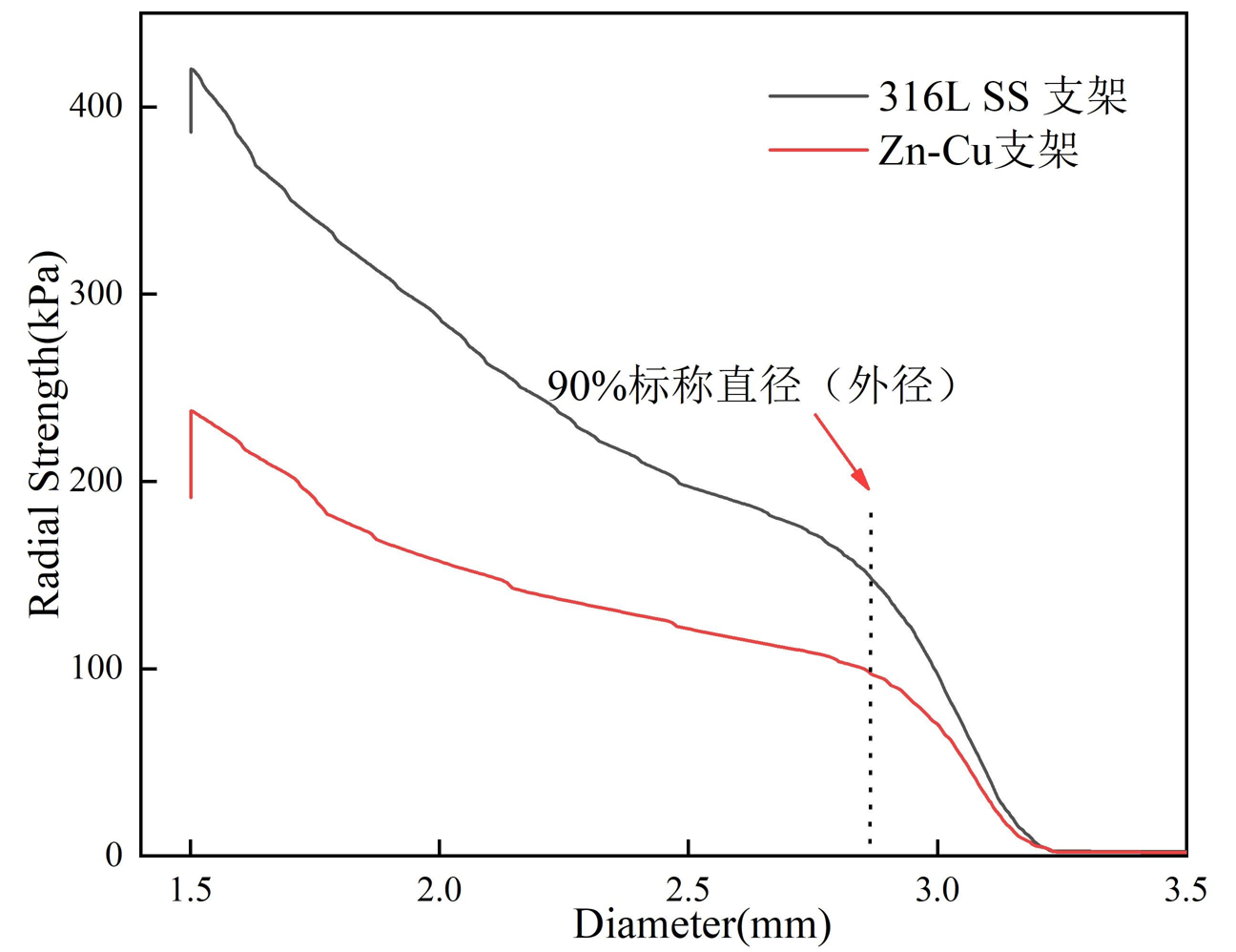
径向支撑强度测试结果如图4-17所示,虚线为90%标称直径位置,将该位置的径向支撑力定义为支架的径向支撑强度。之前的研究认为,血管给冠脉支架造成的径向压力为175 mmHg(23.33 kPa),考虑到安全系数,冠脉支架的最小径向支撑强度应为300 mmHg(40.00 kPa)。图4-17可知,Zn-Cu支架的径向支撑强度为113.59±2.69 kPa,约为传统316L SS支架径向支撑强度182.51±13.60 kPa的62.2%,为冠脉支架所需径向支撑强度的2.84倍,能够满足冠脉支架的要求。在满足支架径向支撑强度的前提下,支架壁应尽量薄。较薄的支架壁厚意味着支架压握后容易获得更小的通过直径(crossing profile),更容易通过血管,从而带来较低的再狭窄率相关和更小的血管损伤;此外较薄的壁厚还有利于支架植入后在血管局部获得更高的血流通过面积,因此是冠状动脉支架的关键性能。由图4-17可知,壁厚为100 μm的Zn-Cu支架已经足够满足冠脉血管对支架径向支撑强度的要求。该壁厚与主流不可降解支架处于相同水平,低于已报道用于临床使用的“BVS”支架(PLLA材质,150 μm)、“NeoVas”支架(PLLA材质,160 μm)、“DREAMS 2G”支架 (WE43镁合金材质,140 μm) 、和“AMS-1”支架(WE43镁合金材质,165 μm)。Zn-Cu支架较好的平衡了支架壁厚与支架径向支撑强度之间的矛盾,具有很好的临床应用前景。
The test results of the radial support strength are shown in Figure 4-17. The dotted line is the position of 90% of the nominal diameter. The radial support force at this position is defined as the radial support strength of the stent. Previous studies have concluded that the radial pressure caused by the blood vessel on the coronary stent is 175 mmHg (23.33 kPa). Considering the safety factor, the minimum radial support strength of the coronary stent should be 300 mmHg (40.00 kPa). Figure 4-17 shows that the radial support strength of the Zn-Cu stent is 113.59±2.69 kPa, which is about 62.2% of the traditional 316L SS stent radial support strength of 182.51±13.60 kPa, which is the required radial support strength of the coronary stent 2.84 times, which can meet the requirements of coronary stents. Under the premise of satisfying the radial support strength of the stent, the stent wall should be as thin as possible. The thinner wall thickness of the stent means that the stent is easier to obtain a smaller crossing profile after being crimped, and it is easier to pass through the blood vessel, resulting in a lower restenosis rate and less blood vessel damage; in addition, the thinner The wall thickness is also conducive to obtaining a higher blood flow area in the blood vessel after the stent is implanted, so it is the key performance of the coronary stent. It can be seen from Figure 4-17 that a Zn-Cu stent with a wall thickness of 100 μm is sufficient to meet the requirements of coronary vessels for the radial support strength of the stent. The wall thickness is at the same level as mainstream non-degradable stents, which is lower than the “BVS” stents (PLLA material, 150 μm), “NeoVas” stents (PLLA material, 160 μm), and “DREAMS 2G” stents that have been reported for clinical use. (WE43 magnesium alloy material, 140 μm), and "AMS-1" bracket (WE43 magnesium alloy material, 165 μm). The Zn-Cu stent balances the contradiction between the wall thickness of the stent and the radial support strength of the stent, and has a good clinical application prospect.